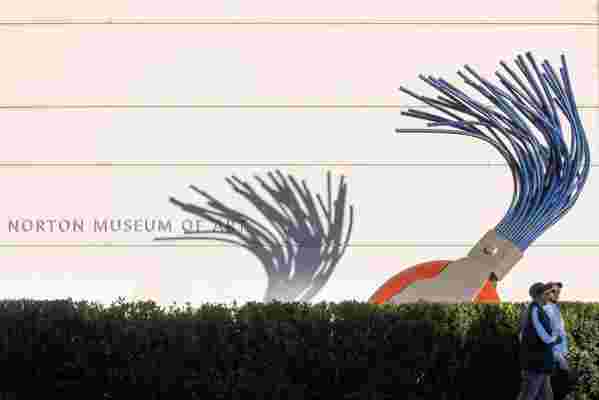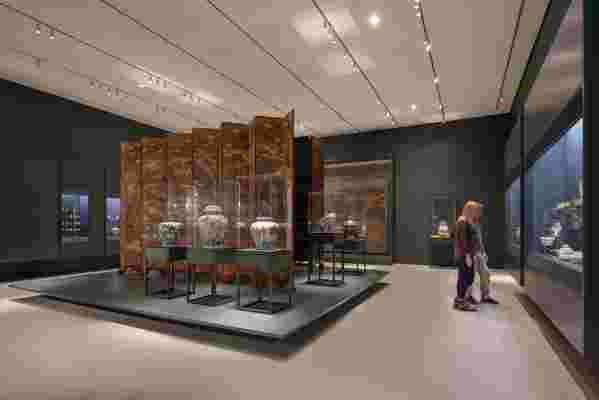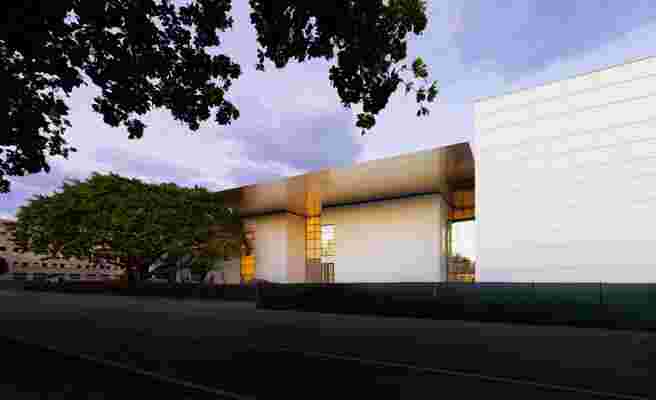December 03,2022
Inside Norman Foster’s Reimagined Norton Museum
by David Stewart
What began as an informal conversation in 2010 between the Norton Musuem's executive director and CEO, Hope Alswang, and local arts patron Gilbert C. Maurer lead to an introduction to Sir Norman Foster and the presentation of a master architectural plan to the museum’s board shortly thereafter. Foster's firm, Foster + Partners, was the only one ever discussed for the renovation project , and Maurer—who sits on the board of the Hearst Corporation, housed in a Foster + Partners building—was the catalyst. The mandate was clear: In order for the museum to evolve, it needed a new home.
The 1995 and 2001 additions to the 1941 Marion Sims Wyeth Art Deco building weren’t doing what the museum needed them to do. “The problem was the connections between spaces wasn’t as clear as it should have been,” says Alswang. “It became clear that the additions didn’t allow us any room to grow and the buildings just didn’t relate to each other well.” Alswang also noted that as the work and scale of contemporary art has gotten more monumental; the museum needed more space to collect ambitiously. “Its additions destroyed the symmetry of the original design, and the relocation of the main entrance to the side of the building was obscured and dominated by car parking,” says Foster. “The new master plan restores the logic of Wyeth’s plan, reasserting the clarity of the main axis, balancing the different building heights, and providing flexible, welcoming visitor facilities to attract a wider local and international audience.”

Heyman Plaza, with its 1999 Claes Oldenberg sculpture of a typewriter eraser, Typewriter Eraser, Scale X .
“From my perspective, great art deserves great architecture,” says Alswang. “If you want to show important artists and you want to work with artists, you owe them the opportunity to show their work in the most beautiful surroundings possible.” For the museum’s chief, it was not only a curatorial issue but also an educational issue. There weren’t enough classrooms or seminar and workshop spaces to be able to offer programs for students, young and mature, in the community. Now there is 50 percent more space in which to engage people. “We have an older audience of retirees who are hungry for using us in great ways,” Alswang notes. “They’re a gift. They read every label, take every tour, go to every talk. We have a huge interest in lifelong learners.”

The museum's new Chinese Gallery.
To achieve the museum's aims, Foster was tasked with restoring logic and creating a better flow, rationality, and circulation to the spaces, which over the years had become awkwardly divided, to improve the visitor experience. They made the building distinctly identifiable from the architecture of its neighbors and physically appropriate to its setting and added an outdoor tropical garden landscape to make the institution more of a destination. (“We wanted it to feel more Floridian,” says Alswang.) Foster + Partners also sought to relocate the entry of the museum to South Dixie Highway, thus recreating the asymmetry of the building’s original design and giving it a more public presence on the thoroughfare. (This is only phase one of the master plan; there are two more phases that will add 30,000 square feet down the road.)

The building's new entrance, along South Dixie Highway, in the midst of construction.
“Over the years, the museum had lost its sense of identity in the neighborhood,” says Foster. “The extension’s new shimmering roof curves around the tree canopy, uniting the entire ensemble while shading the entrance plaza,” says Foster. “Situated under the new sweeping canopy, the plaza provides the first impression of the building on approach, setting the stage for the rest of the museum experience.”
A new rooftop sign announces the Norton's guiding principle.
Eight years later, the result of this expansion is a new 59,000-square-foot West Wing, comprised of four multistory stucco pavilions to house art. With 35 percent more space for exhibitions, the 6.3-acre campus can now offer 133,000 square feet of gallery space. The 1941 building remains, but has been repurposed and reconfigured to create smarter spaces. The public sculpture garden, Foster’s first design of this kind, will feature 14 works from artists like Mark di Suvero and Keith Haring as well as tropical gardens featuring native flora. These new verdant grounds will offer the community a great gathering place with year-round outdoor dining.
But, of course, raising the money for a $100 million expansion didn’t happen overnight. “A lot of people stepped up and did incredible things to help us achieve our goal,” says Alswang. Donors like Leonard Lauder, whose name adorns the new restaurant alongside his late wife's, Evelyn, Beth Rudin DeWoody, Ruth and Carl Shapiro, and Ronnie Heyman have made this project possible by donating their time, artworks, and money.
The new Jodi Ann Saltzman Gallery.
Donated by board member and collector Heyman, an iconic 1999 Claes Oldenberg sculpture of a typewriter eraser, Typewriter Eraser, Scale X , will flank the museum’s new entrance, Heyman Plaza. “This is a significant work of art, which is in scale with the space and hearkens back to a predigital age,” says Foster. “It will raise provocative questions with a younger audience, which will probably have never seen a typewriter—it is a place of arrival, expectation, and contemplation.” A 210-seat auditorium with great acoustics and raked seating, meeting rooms, an event lawn for outdoor programs, museum shop, and restaurant with garden seating will bring attendees to the institution in new ways.
Ultimately, “the museum seeks to create a new social focus for the community and lays the foundations for the future growth of the Norton as one of Florida’s leading cultural institutions,” says Foster. The light-filled Ruth and Carl Shapiro Great Hall off the entrance boasts seating, books, and a coffee bar, making it a home for visitors to get acclimated to the new spaces. “The Great Hall is a very moving experience for the visitor with its height, front window, and oculus,” says Cheryl Brutvan, the museum’s director of curatorial affairs.
After the opening events in early February and nine years at the museum’s helm, Alswang has decided to leave her official role at the Norton, but knows the institution is in great hands. “I’m very proud," she says, "to be leaving the community with a building that’s the envy of any museum anywhere."






